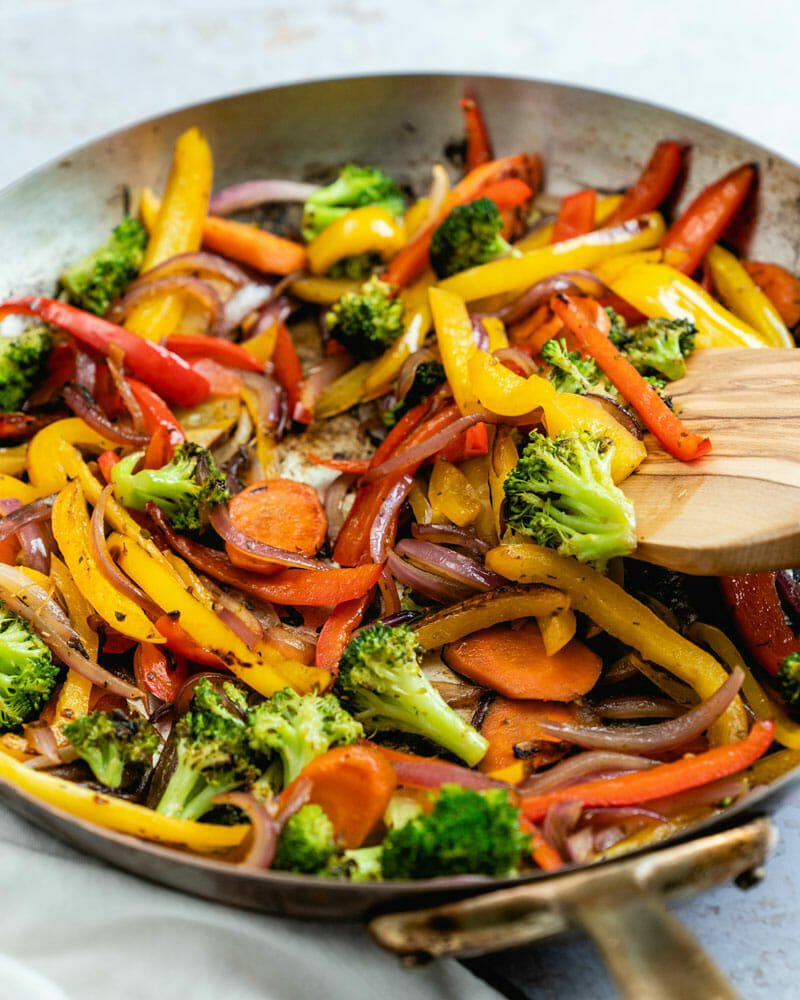Here’s how to make the best sauteed vegetables: colorful, flavor-packed and crisp tender! Gone are the days of the soggy veggie saute.
Looking for a quick and easy side dish? Here’s the fastest way to get colorful veggies to jump onto your plate: the Ultimate Sautéed Vegetables recipe. The good old veggie saute is often done wrong: it’s super soggy, or completely bland in flavor. Think of that pile of limp zucchini and carrots you might eat at a wedding buffet. So why don’t we do a total makeover on the old veggie saute? These sauteed vegetables are beautifully colored, bursting with flavor and crisp tender in texture. They’re the perfect side dish you’ve never had. Ready to get started?
How to sauté vegetables: the basics
Sautéing is hands down the fastest way to cook vegetables. The word comes from the French work “to jump,” meaning that you’ll need to keep stirring or flipping the pan for the entire cook time. To sauté you’ll need a good skillet and a fat to use for cooking, typically either olive oil or butter. Sauteing browns the outside of the food, which helps complex flavors to develop (called the Maillard reaction, the scientific term for browning food). Here are the basic steps for sauteeing vegetables, and the approximate timing for each type of vegetable:
- hop the vegetable into bite-sized pieces.
- Add olive oil to a large skillet and heat it over medium high heat.
- Add the veggies and cook until tender, stirring frequently. Use the following approximate timing:
- Frozen peas:~2 minutes
- Greens (kale, spinach):~3 minutes
- Mushrooms:~7 minutes
- Broccoli, asparagus: ~8 minutes
- Cauliflower, onions:~10 minutes
- Bell peppers:~10 to 12 minutes
- Carrots:~12 minutes
Ingredients for these ultimate sauteed vegetables
For this sautéed vegetables recipe, we wanted to pick vegetables that would cook in approximately the same amount of time. When you choose vegetables with different cook times, you can add the longest cooking veggies first and then stagger the start times of the short cooking vegetables. This recipe we customized so you can cook them all at once! We also wanted to pick a rainbow of colors to make a visually appealing vegan side dish, and load on the nutrients. Here’s what we ended up with:
- Bell peppers: Bell peppers are beautiful, delicious, and are loaded with Vitamin C. A medium red bell pepper provides a whopping 169% of your daily vitamin C! (Source)
- Red onion: Red onion brings a delicious complimentary flavoring to the sauteed veggies.
- Carrot: Carrot brings color, a big dose of Vitamin A, and a sweet flavor. (Source)
- Broccoli: Broccoli adds a splash of green, fiber and protein. We prefer it in a saute over cauliflower since it cooks faster.
The best pan for sauteed vegetables
You can make sauteed vegetables in any type of pan! You’ll want a large skillet for this recipe, large enough to hold all of the vegetables. In terms of materials, each pan material cooks differently. Here’s what to know:
- Aluminum or copper: You’ll get the best browning on the edges of the veggies when you use aluminum or copper. This type of skillet is fantastic for sauteing and also searing salmon or scallops.
- Non stick:You can also saute in non-stick pans!
Here’s how to make the best sauteed vegetables: colorful, flavor-packed and crisp tender! Gone are the days of the soggy veggie saute.
Ingredients
- 2multi-colored bell peppers (we used red and yellow)
- 1medium red onion
- 1large carrot
- 1head broccoli (8 ounces, stem on)
- 2 tablespoonsolive oil, divided
- 1 teaspoondried oregano
- ½ teaspoonkosher salt
- Fresh ground black pepper
Instructions
- Thinly slice the peppers. Slice the onion. Cut the carrot into thin rounds, on the bias. Cut the broccoli into small florets.
- Toss the vegetables in a bowl with 1 tablespoon olive oil and the oregano, kosher salt and plenty of fresh ground black pepper.
- In large skillet, heat the remaining 1 tablespoon olive oil over medium high heat. Cook for 10 to 12 minutes until tender and lightly charred, stirring occasionally. Taste and add a few pinches of additional salt to taste. Serve immediately.























